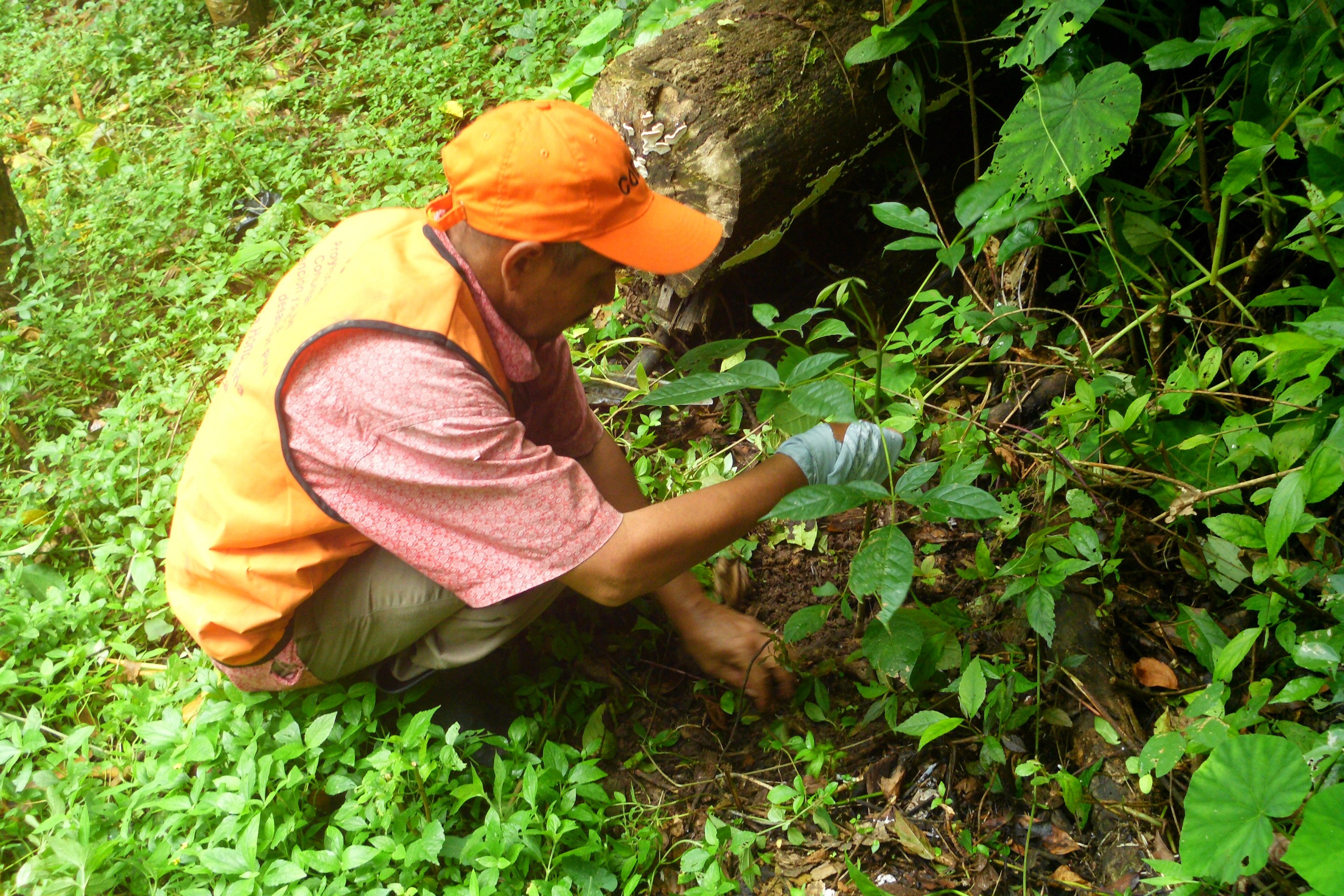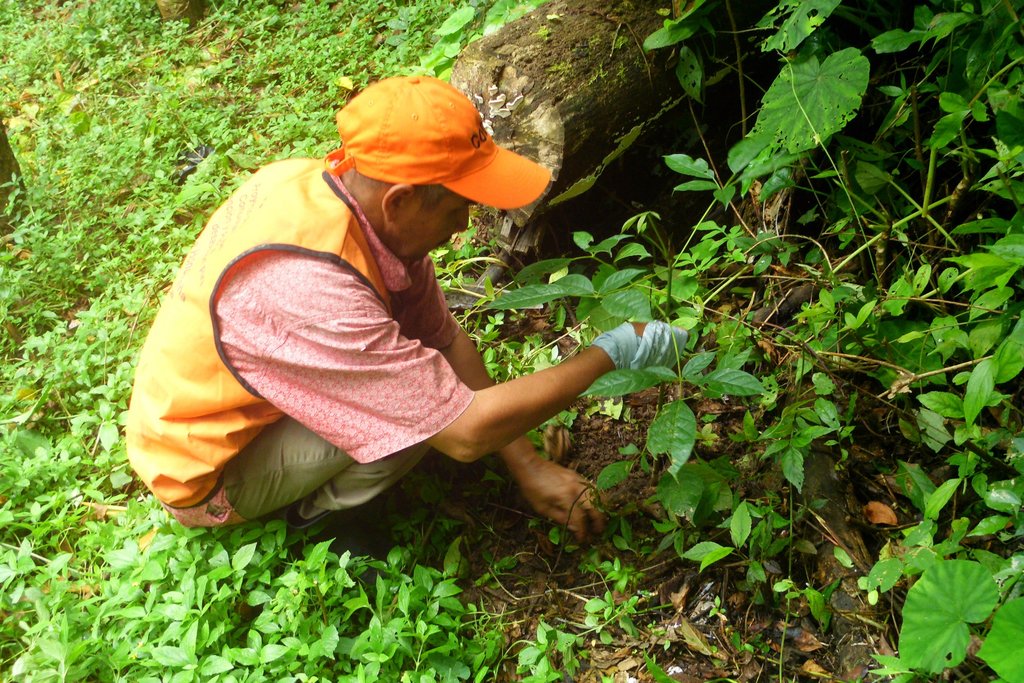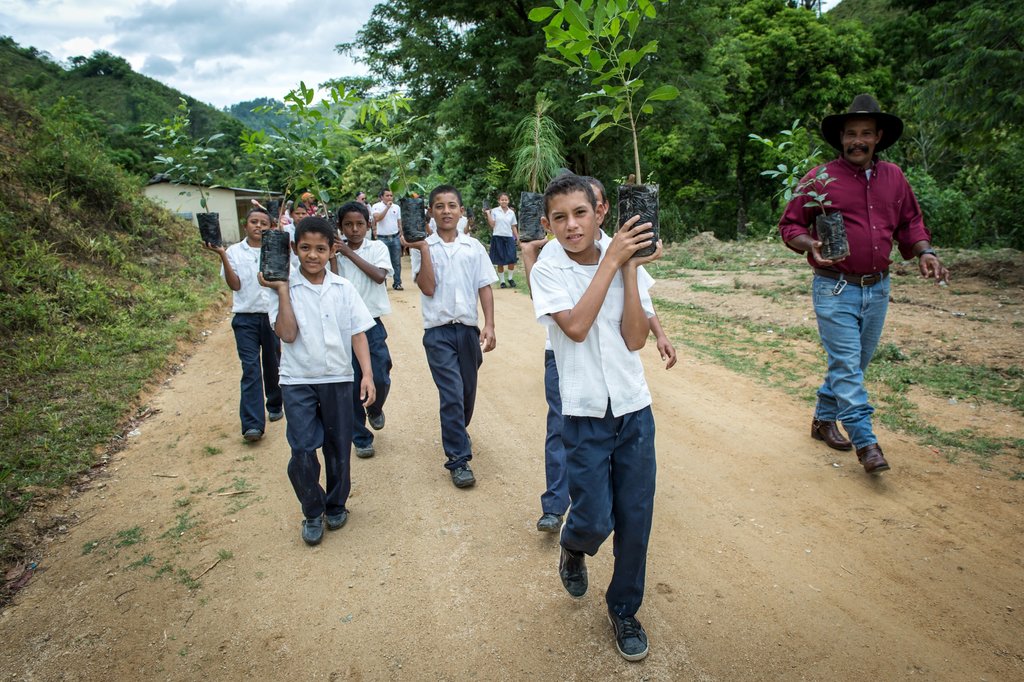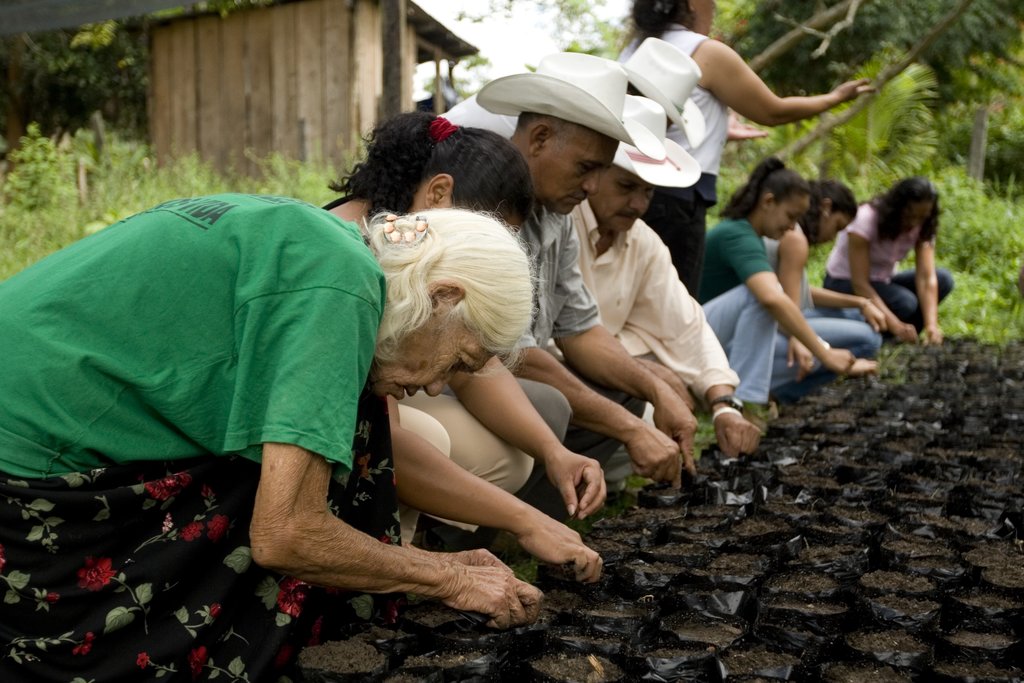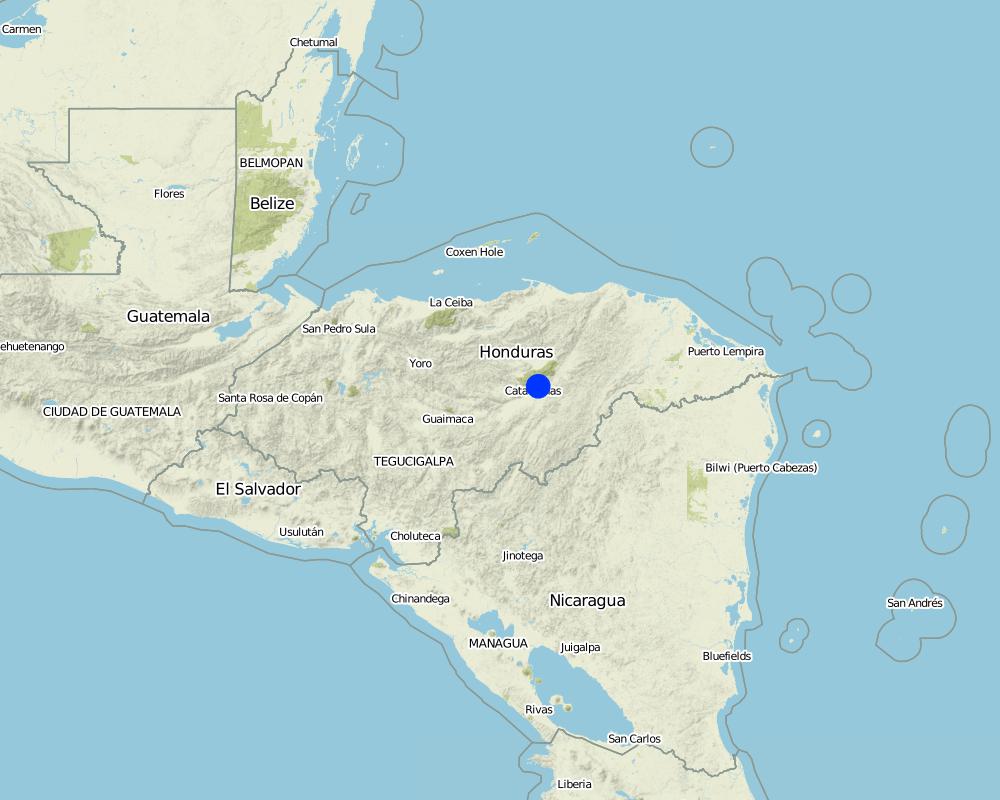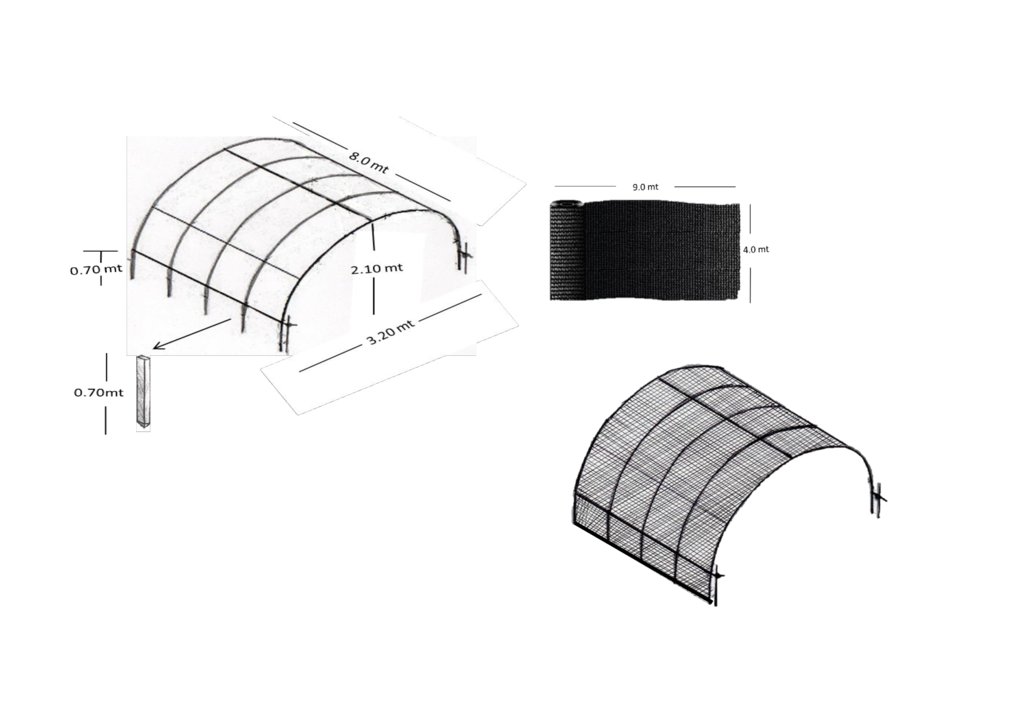Community protection of microbasins through reforestation [Honduras]
- Creation:
- Update:
- Compiler: Helen Gambon
- Editor: Anton Jöhr
- Reviewers: Johanna Jacobi, Alexandra Gavilano
technologies_750 - Honduras
View sections
Expand all Collapse all1. General information
1.2 Contact details of resource persons and institutions involved in the assessment and documentation of the Technology
Key resource person(s)
land user:
Escalante Beltrán Trinidad
Jamasquire Water Management Board
Honduras
SLM specialist:
Paguada Carmen
Honduran/ Swiss Red Cross
Honduras
Name of project which facilitated the documentation/ evaluation of the Technology (if relevant)
Book project: where people and their land are safer - A Compendium of Good Practices in Disaster Risk Reduction (DRR) (where people and their land are safer)Name of the institution(s) which facilitated the documentation/ evaluation of the Technology (if relevant)
Swiss Red Cross (Swiss Red Cross) - Switzerland1.3 Conditions regarding the use of data documented through WOCAT
The compiler and key resource person(s) accept the conditions regarding the use of data documented through WOCAT:
Yes
1.4 Declaration on sustainability of the described Technology
Is the Technology described here problematic with regard to land degradation, so that it cannot be declared a sustainable land management technology?
No
1.5 Reference to Questionnaire(s) on SLM Approaches (documented using WOCAT)
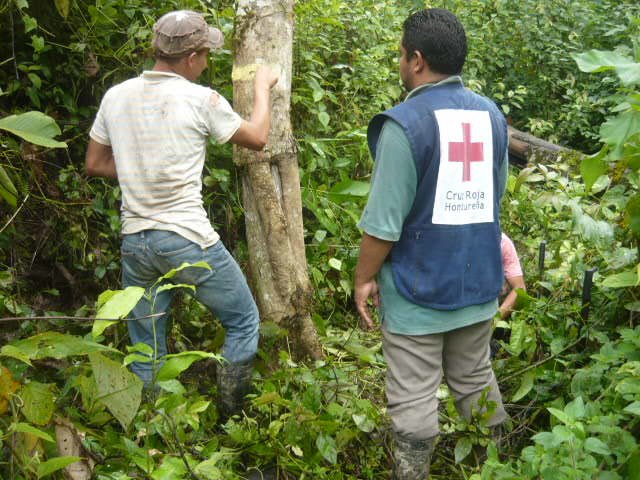
Issuing a Decree to Ensure the Legal Protection … [Honduras]
Honduran Forest Legislation establishes the strict protection of microbasins from human exploitation. However, in practice, there is an accelerated rate of microbasin degradation brought on by land use changes that turn forest lands into crop lands. Through sensitization, raising awareness, and training aimed at the general population and Water Management …
- Compiler: Helen Gambon
2. Description of the SLM Technology
2.1 Short description of the Technology
Definition of the Technology:
Microbasins providing drinking water to many communities frequently suffer from deforestation and are used as grazing areas, for coffee production areas or for other types of crops. As a whole, communities choose to protect microbasins and ensure reforestation resorting to legal protection, thus ensuring the quantity and quality of their water.
2.2 Detailed description of the Technology
Description:
In recent years, the intervention site located in the Department of Olancho, Honduras has been suffering from soil degradation in microbasin areas due to changes in land use. The impact on the quantity and quality of the water supply is severe. This increases erosion and water pollution, which, in turn, affect the health of the area's population. The "Resiliencia" project undertaken by the Honduran/ Swiss Red Cross enhances the soil conservation and management capacity of different community sectors, such as the Local Emergency Committees (CODEL, Spanish acronym for Comités de Emergencia Local), Water Management Boards and schools. Communities whose water supply depends on microbasins undertake joint reforestation efforts. They implement community greenhouses that can produce 800 plants. Typically, native species are used
(such as Samanea saman, Tabebuia rosea, Inga edulis, Anacardium occidentale, Pinus oocarpa, Cordia alliodora) as well with fruit varieties (eg. Syzygium malaccense, Moringa oleífera, Tamarindus indica), and in some cases, these crops are complemented with wood crops (eg. Swietenia macrophylla, Cedrela odorata, Tectona grandis). Seedlings are transplanted from the seedbed into the greenhouse once they have grown 4 knots and achieved a height of 7-10 centimeters. Once ready to be transplanted in the field, irrigation frequency and exposure to shade are gradually reduced. Plants are taken to the plantation (microbasin) through different means of transportation (on foot, mule or, whenever possible, automobiles) during the early hours of the day or in the afternoon to avoid harsh sunlight. Holes are dug with manual excavator. The plants are placed according to the purpose of the plantation. In the case of microbasins/conservation areas, plants are placed at a distance of 8x8 meters to 10x10 meters. The polyethylene bag is removed and the tree is placed in the hole with the substratum. The weather conditions and the soil conditions in the intervention site require no further measures such as irrigation or fertilizers. Reforested areas are protected with wire and designated as sites that will not be used. Communities are actively involved in reforestation and replicate technology by means of community greenhouses and reforersting additional land plots.
2.3 Photos of the Technology
2.5 Country/ region/ locations where the Technology has been applied and which are covered by this assessment
Country:
Honduras
Region/ State/ Province:
Departament of Olancho
Further specification of location:
Municipality of Catacamas, Jamasquire community
Specify the spread of the Technology:
- evenly spread over an area
If precise area is not known, indicate approximate area covered:
- 0.1-1 km2
Map
×2.6 Date of implementation
Indicate year of implementation:
2013
2.7 Introduction of the Technology
Specify how the Technology was introduced:
- through projects/ external interventions
3. Classification of the SLM Technology
3.1 Main purpose(s) of the Technology
- reduce, prevent, restore land degradation
- conserve ecosystem
- reduce risk of disasters
3.2 Current land use type(s) where the Technology is applied
Land use mixed within the same land unit:
Yes
Specify mixed land use (crops/ grazing/ trees):
- Agroforestry

Cropland
- Tree and shrub cropping
Tree and shrub cropping - Specify crops:
- cashew
- fruits, other
- Inga edulis (cf. Fabaceae), Syzygium malaccense (cf. Flowering tree but not cashew), Moringa oleífera, Tamarindus indica, Cedrela odorata

Forest/ woodlands
- Tree plantation, afforestation
Tree plantation, afforestation: Specify origin and composition of species:
- Mixed varieties
Type of tree:
- Cordia alliadora
- Pinus oocarpa
- Swietenia macrophylla
- Tectona grandis
- Samanea saman, Tabebuia rosea
Products and services:
- Nature conservation/ protection
- Protection against natural hazards
- Conservation/Protection of microbasin
Comments:
Typically, native species are used (such as Samanea saman, Tabebuia rosea, Inga edulis, Anacardium occidentale, Pinus oocarpa, Cordia alliodora) as well with fruit varieties (eg. Syzygium malaccense, Moringa oleífera, Tamarindus indica), and in some cases, these crops are complemented with wood crops (eg. Swietenia macrophylla, Cedrela odorata, Tectona grandis).
3.3 Has land use changed due to the implementation of the Technology?
Has land use changed due to the implementation of the Technology?
- Yes (Please fill out the questions below with regard to the land use before implementation of the Technology)
Land use mixed within the same land unit:
Yes
Specify mixed land use (crops/ grazing/ trees):
- Agro-pastoralism (incl. integrated crop-livestock)

Cropland
- Annual cropping
Annual cropping - Specify crops:
- cereals - maize
- legumes and pulses - beans

Grazing land
Comments:
In Jamasquire, the microbasin had been completely deforested and used for grazing and growing corn and beans. 40 years ago, the community reforested a part of the microbasin. However, the rest of the microbasin was still used, until 2013, when said area began to be reforested.
3.4 Water supply
Water supply for the land on which the Technology is applied:
- rainfed
3.5 SLM group to which the Technology belongs
- natural and semi-natural forest management
- area closure (stop use, support restoration)
- ecosystem-based disaster risk reduction
3.6 SLM measures comprising the Technology

vegetative measures
- V1: Tree and shrub cover

management measures
- M1: Change of land use type
3.7 Main types of land degradation addressed by the Technology

soil erosion by water
- Wm: mass movements/ landslides

water degradation
- Hs: change in quantity of surface water
- Hq: decline of groundwater quality
3.8 Prevention, reduction, or restoration of land degradation
Specify the goal of the Technology with regard to land degradation:
- reduce land degradation
4. Technical specifications, implementation activities, inputs, and costs
4.1 Technical drawing of the Technology
Technical specifications (related to technical drawing):
1. Ground: The ground must be even with good drainage. There should be a water source close-by for irrigation. A populated place close to the plantation is recommended for workers. Furthermore, good access to roads is needed to facilitate transport of the plants.
2. Calculation of production area: This depends on the quantity and the type of plants. However, the standard size for tree nurseries under the project is 8 m long, 3.20 m wide and 2.10 m high. 800 plants can be produced in this area.
3. Construction of tree nursery: Protect the tree nursery with a perimeter fence to guard against animals and people. Laying out of the terraces is done using a rope - and the terraces are 1.10 m wide and 8 m long. They are constructed along both sides of the tree nursery. The width of the passageway between the terraces must allow for a wheelbarrow. The productive area should be oriented from east to west so that plants have sunlight for as much of the day as possible.
4. Preparation of the substrate: The mixture for filling the bags is prepared from one part organic material or black soil and two parts of sand. The substrate is sterilized using boiling water and is covered to keep the heat in.
5. Seeding: If the seeds are small, they are broadcast into the seedbeds. If medium sized they are placed in small drills. If the seeds are big enough they are seeded directly into the bags. They should be well covered by soil. The quantity of seeds sown must allow for potential losses through germination, damage during transport, disease or malformation.
6. Maintenance of plants in the seedbed: The plants are irrigated 1-2 times per day, preferably early in the morning and late in the evening. The volume used for irrigation is 3-5 litres per m2 of seedbed. Mulch is applied to provide shade and keep the ground moist in the seedbed - and again after transplanting into the bags. Weeding is done once a week.
7. Transplanting into the bags: This is carried out when the seedlings are around 7-10 cm tall. Soil is removed from the seedlings, they are carefully removed and placed in a container with water until the soil is washed off. Roots longer than 5 cm are cut, but the amount pruned should not be more than 30% of the length of the root. Diseased, malformed and small seedlings are discarded, leaving only the best ones. A hole is made in the centre of the substrate, deep enough to place a seedling without bending the roots; then the seedling is planted up to the stem; and finally the hole is re-filled with substrate. The polyethylene bags are arranged on the ground in rows, grouped in compact blocks.
8. Maintenance of the plants in the bags: Watering the seedlings is needed daily after transplanting. Provide shade until the seedlings are rooted - which is indicated when they produce new leaves. Weeds are removed from each container.
9. Acclimatization of seedlings: This is recommended for plants to be able to adapt to sudden environmental changes and survive once they are planted out. When the plants approach the size for transplantation, the frequency of irrigation must be reduced and the shade should also be gradually eliminated.
10. Field Planting: This process should be done in the early morning. Before taking to the field, all diseased or undersized plants are discarded. Plant spacing depends on the purpose of the plantation. In a micro-catchment / conservation area the spacing used is from 8 m x 8 m to 10 m x 10 m.
The used plant species are: Samanea saman, Tabebuia rosea, Inga edulis, Anacardium occidentale, Syzygium malaccense, Moringa oleifera, Pinus oocarpa, Tamarindus indica and Cordia alliodora.
Author:
Swiss / Honduran Red Cross
4.2 General information regarding the calculation of inputs and costs
Specify how costs and inputs were calculated:
- per Technology area
Indicate size and area unit:
1 hectare
other/ national currency (specify):
Lempiras
If relevant, indicate exchange rate from USD to local currency (e.g. 1 USD = 79.9 Brazilian Real): 1 USD =:
23.0
Indicate average wage cost of hired labour per day:
150 Lempiras
4.3 Establishment activities
| Activity | Timing (season) | |
|---|---|---|
| 1. | Greenhouse construction | |
| 2. | Seeds are placed in bags full of soil | January/February |
| 3. | Seeds are watered | 1-2 times a day in seedbed, Once a day in the bag, reduce watering 2 months after transplanted |
| 4. | Transport to place where plants will be transplanted | Early morning or after sundown |
| 5. | Dig holes at intervals of 8-10 meters and plant the tree | May |
| 6. | Fence area off with wire | Only if necessary |
4.4 Costs and inputs needed for establishment
| Specify input | Unit | Quantity | Costs per Unit | Total costs per input | % of costs borne by land users | |
|---|---|---|---|---|---|---|
| Labour | Untrained labor | person per day | 600.0 | 150.0 | 90000.0 | 100.0 |
| Equipment | Bar | piece | 3.0 | 20.0 | 60.0 | 100.0 |
| Equipment | Manual Excavator | piece | 3.0 | 180.0 | 540.0 | 100.0 |
| Equipment | Hammer | piece | 5.0 | 1.0 | 5.0 | |
| Equipment | Staples | pounds | 21.0 | 20.0 | 420.0 | 100.0 |
| Plant material | bags | piece | 800.0 | 0.5 | 400.0 | |
| Plant material | soil | load | 3.0 | 5000.0 | 15000.0 | 100.0 |
| Plant material | Cedrela odorata Seeds | kg | 0.2 | 1200.0 | 240.0 | |
| Plant material | Swietenia macrophylla Seeds | kg | 1.0 | 600.0 | 600.0 | |
| Plant material | Khaya senegalensis Seeds | kg | 1.0 | 3600.0 | 3600.0 | |
| Plant material | Cordia alliodora Seeds | kg | 0.2 | 1200.0 | 240.0 | |
| Plant material | Anacardium occidentalis Seeds | kg | 1.0 | 100.0 | 100.0 | |
| Plant material | Albizzia guachepele Seeds | kg | 0.5 | 1800.0 | 900.0 | |
| Construction material | barbed wire | roll | 5.0 | 450.0 | 2250.0 | |
| Construction material | posts | piece | 350.0 | 25.0 | 8750.0 | 100.0 |
| Other | Water for seedlings | month | 3.0 | 50.0 | 150.0 | 100.0 |
| Other | Transportation of plants | trip | 2.0 | 500.0 | 1000.0 | |
| Total costs for establishment of the Technology | 124255.0 | |||||
| Total costs for establishment of the Technology in USD | 5402.39 | |||||
If land user bore less than 100% of costs, indicate who covered the remaining costs:
Honduran/ Swiss Red Cross
Comments:
Costs calculated based on a 36 ha. area. Each area requires 3300 Lempiras.
4.5 Maintenance/ recurrent activities
| Activity | Timing/ frequency | |
|---|---|---|
| 1. | Clean the fence | April, to avoid fires, November to remove vines |
| 2. | Monitor to ensure the area is protected | Continuously |
4.6 Costs and inputs needed for maintenance/ recurrent activities (per year)
| Specify input | Unit | Quantity | Costs per Unit | Total costs per input | % of costs borne by land users | |
|---|---|---|---|---|---|---|
| Labour | Untrained labor | person - day | 160.0 | 150.0 | 24000.0 | 100.0 |
| Equipment | Machete | piece | 80.0 | 2.0 | 160.0 | |
| Total costs for maintenance of the Technology | 24160.0 | |||||
| Total costs for maintenance of the Technology in USD | 1050.43 | |||||
4.7 Most important factors affecting the costs
Describe the most determinate factors affecting the costs:
Labor
5. Natural and human environment
5.1 Climate
Annual rainfall
- < 250 mm
- 251-500 mm
- 501-750 mm
- 751-1,000 mm
- 1,001-1,500 mm
- 1,501-2,000 mm
- 2,001-3,000 mm
- 3,001-4,000 mm
- > 4,000 mm
Specify average annual rainfall (if known), in mm:
1400.00
Specifications/ comments on rainfall:
Dry season from January to June; rainy season between June and October, with a heatwave in August.
Agro-climatic zone
- sub-humid
5.2 Topography
Slopes on average:
- flat (0-2%)
- gentle (3-5%)
- moderate (6-10%)
- rolling (11-15%)
- hilly (16-30%)
- steep (31-60%)
- very steep (>60%)
Landforms:
- plateau/plains
- ridges
- mountain slopes
- hill slopes
- footslopes
- valley floors
Altitudinal zone:
- 0-100 m a.s.l.
- 101-500 m a.s.l.
- 501-1,000 m a.s.l.
- 1,001-1,500 m a.s.l.
- 1,501-2,000 m a.s.l.
- 2,001-2,500 m a.s.l.
- 2,501-3,000 m a.s.l.
- 3,001-4,000 m a.s.l.
- > 4,000 m a.s.l.
Indicate if the Technology is specifically applied in:
- not relevant
5.3 Soils
Soil depth on average:
- very shallow (0-20 cm)
- shallow (21-50 cm)
- moderately deep (51-80 cm)
- deep (81-120 cm)
- very deep (> 120 cm)
Soil texture (topsoil):
- coarse/ light (sandy)
Topsoil organic matter:
- medium (1-3%)
5.4 Water availability and quality
Ground water table:
> 50 m
Availability of surface water:
good
Water quality (untreated):
good drinking water
Is water salinity a problem?
No
Is flooding of the area occurring?
No
5.5 Biodiversity
Species diversity:
- low
Habitat diversity:
- low
5.6 Characteristics of land users applying the Technology
Sedentary or nomadic:
- Sedentary
Market orientation of production system:
- mixed (subsistence/ commercial)
Off-farm income:
- 10-50% of all income
Relative level of wealth:
- poor
Individuals or groups:
- individual/ household
Level of mechanization:
- manual work
Gender:
- men
Age of land users:
- youth
- middle-aged
5.7 Average area of land used by land users applying the Technology
- < 0.5 ha
- 0.5-1 ha
- 1-2 ha
- 2-5 ha
- 5-15 ha
- 15-50 ha
- 50-100 ha
- 100-500 ha
- 500-1,000 ha
- 1,000-10,000 ha
- > 10,000 ha
Is this considered small-, medium- or large-scale (referring to local context)?
- medium-scale
Comments:
There is a significant number of people with land between 0 - 120 ha. However, most have lands that are 6 -12 ha.
5.8 Land ownership, land use rights, and water use rights
Land ownership:
- communal/ village
- individual, not titled
Land use rights:
- leased
- individual
Water use rights:
- communal (organized)
Comments:
The microbasin where reforestation took place is community land and should not be used. However, there were 3 families using the land to grow their own corn and bean crops and for their livestock. The community has taken the land from them to reforest and protect the microbasin.
5.9 Access to services and infrastructure
health:
- poor
- moderate
- good
education:
- poor
- moderate
- good
technical assistance:
- poor
- moderate
- good
employment (e.g. off-farm):
- poor
- moderate
- good
markets:
- poor
- moderate
- good
energy:
- poor
- moderate
- good
roads and transport:
- poor
- moderate
- good
drinking water and sanitation:
- poor
- moderate
- good
financial services:
- poor
- moderate
- good
6. Impacts and concluding statements
6.1 On-site impacts the Technology has shown
Socio-economic impacts
Water availability and quality
drinking water availability
Quantity before SLM:
Amount before SLM
Quantity after SLM:
Amount after SLM
Comments/ specify:
Availability was not yet a problem, thus, people from the community believe
reforestation is a long term investment.
drinking water quality
Quantity before SLM:
Amount before SLM
Quantity after SLM:
Amount after SLM
Comments/ specify:
Water quality is good and was not yet affected by land use.
Socio-cultural impacts
SLM/ land degradation knowledge
Quantity before SLM:
Amount before SLM
Quantity after SLM:
Amount after SLM
Comments/ specify:
SLM and soil conservation knowledge in the community SLM has increased significantly.
Ecological impacts
Water cycle/ runoff
water quantity
Quantity before SLM:
Amount before SLM
Quantity after SLM:
Amount after SLM
Comments/ specify:
Effects of reforestation will show in the long term.
evaporation
Quantity before SLM:
Amount before SLM
Quantity after SLM:
Amount after SLM
Climate and disaster risk reduction
landslides/ debris flows
Quantity before SLM:
Amount before SLM
Quantity after SLM:
Amount after SLM
Comments/ specify:
The community was severely affected by landslides caused by a tropical storm in 2008; this incident raised awareness on the problems of deforestation and led to reforestation of the microbasin. Since that date, no strong storms or landslides have ocurred.
impacts of cyclones, rain storms
Quantity before SLM:
Amount before SLM
Quantity after SLM:
Amount after SLM
Comments/ specify:
Forests reduce the risk of landslides and the efect will be greater in the long term.
emission of carbon and greenhouse gases
Quantity before SLM:
Amount before SLM
Quantity after SLM:
Amount after SLM
Comments/ specify:
The change in agrarian land use into forests reduces carbon and greenhouse gas emissions.
micro-climate
Quantity before SLM:
Amount before SLM
Quantity after SLM:
Amount after SLM
Comments/ specify:
The forest helps to create a cooler microclimate and has positive effects on health and agricultural production.
6.2 Off-site impacts the Technology has shown
downstream flooding
Quantity before SLM:
Amount before SLM
Quantity after SLM:
Amount after SLM
Comments/ specify:
In the long term, reforestation will help reduce floods in the lower regions of
the river.
impact of greenhouse gases
Quantity before SLM:
Amount before SLM
Quantity after SLM:
Amount after SLM
Comments/ specify:
The forest acts as a carbon buffer.
6.3 Exposure and sensitivity of the Technology to gradual climate change and climate-related extremes/ disasters (as perceived by land users)
Gradual climate change
Gradual climate change
| Season | increase or decrease | How does the Technology cope with it? | |
|---|---|---|---|
| annual temperature | increase | well | |
| seasonal temperature | summer | increase | well |
| seasonal rainfall | summer | decrease | well |
Climate-related extremes (disasters)
Meteorological disasters
| How does the Technology cope with it? | |
|---|---|
| tropical storm | moderately |
| extra-tropical cyclone | well |
Hydrological disasters
| How does the Technology cope with it? | |
|---|---|
| landslide | well |
6.4 Cost-benefit analysis
How do the benefits compare with the establishment costs (from land users’ perspective)?
Short-term returns:
slightly positive
Long-term returns:
positive
How do the benefits compare with the maintenance/ recurrent costs (from land users' perspective)?
Short-term returns:
positive
Long-term returns:
positive
Comments:
The incomes of three families were reduced when land use was changed; from being used for livestock production it became a strictly protected area. The community's population appreciate the value of this to face current risks and see it as a long-term investment to protect the microbasin. The opinions represented in this case study belong to the representatives of the Water Management Board and not on an in-depth assessment of community social dynamics.
6.5 Adoption of the Technology
- > 50%
If available, quantify (no. of households and/ or area covered):
The microbasin supplies water to four communities; all of them are actively involved in its reforestation.
Of all those who have adopted the Technology, how many did so spontaneously, i.e. without receiving any material incentives/ payments?
- 0-10%
6.6 Adaptation
Has the Technology been modified recently to adapt to changing conditions?
No
6.7 Strengths/ advantages/ opportunities of the Technology
| Strengths/ advantages/ opportunities in the land user’s view |
|---|
| Reforestation ensures a safer environmental future by providing water to communities and protecting them from increasingly higher temperatures. |
| Strengths/ advantages/ opportunities in the compiler’s or other key resource person’s view |
|---|
| Hazards posed by landslides and tropical storms/ hurricanes are reduced. |
| A broad range of environmental services, such as water production, regulation of the water cycle, carbon fixation, soil and biodiversity conservation, mitigation of natural disasters, etc. |
6.8 Weaknesses/ disadvantages/ risks of the Technology and ways of overcoming them
| Weaknesses/ disadvantages/ risks in the land user’s view | How can they be overcome? |
|---|---|
| There is always the risk of new deforestation in the future. |
Rules could be established in the community, such as ensuring a new tree is planted for each tree that is cut down. At the national level, legislation promoting sustainable livestock, agricultural forest and production is needed. |
| Weaknesses/ disadvantages/ risks in the compiler’s or other key resource person’s view | How can they be overcome? |
|---|---|
| Lack of forestry management knowledge and improper forest management could result in reforestation not being successful in the long term. | Training and technical support must continue for years after planting trees. |
7. References and links
7.1 Methods/ sources of information
- field visits, field surveys
1
- interviews with land users
1
- interviews with SLM specialists/ experts
2
- compilation from reports and other existing documentation
When were the data compiled (in the field)?
22/11/2016
7.2 References to available publications
Title, author, year, ISBN:
Local responses to global challenges - community based disaster risk reduction. Experiences from Honduras. Case Study. Swiss Red Cross, May 2016
Available from where? Costs?
info@redcross.ch
Links and modules
Expand all Collapse allLinks

Issuing a Decree to Ensure the Legal Protection … [Honduras]
Honduran Forest Legislation establishes the strict protection of microbasins from human exploitation. However, in practice, there is an accelerated rate of microbasin degradation brought on by land use changes that turn forest lands into crop lands. Through sensitization, raising awareness, and training aimed at the general population and Water Management …
- Compiler: Helen Gambon
Modules
No modules


